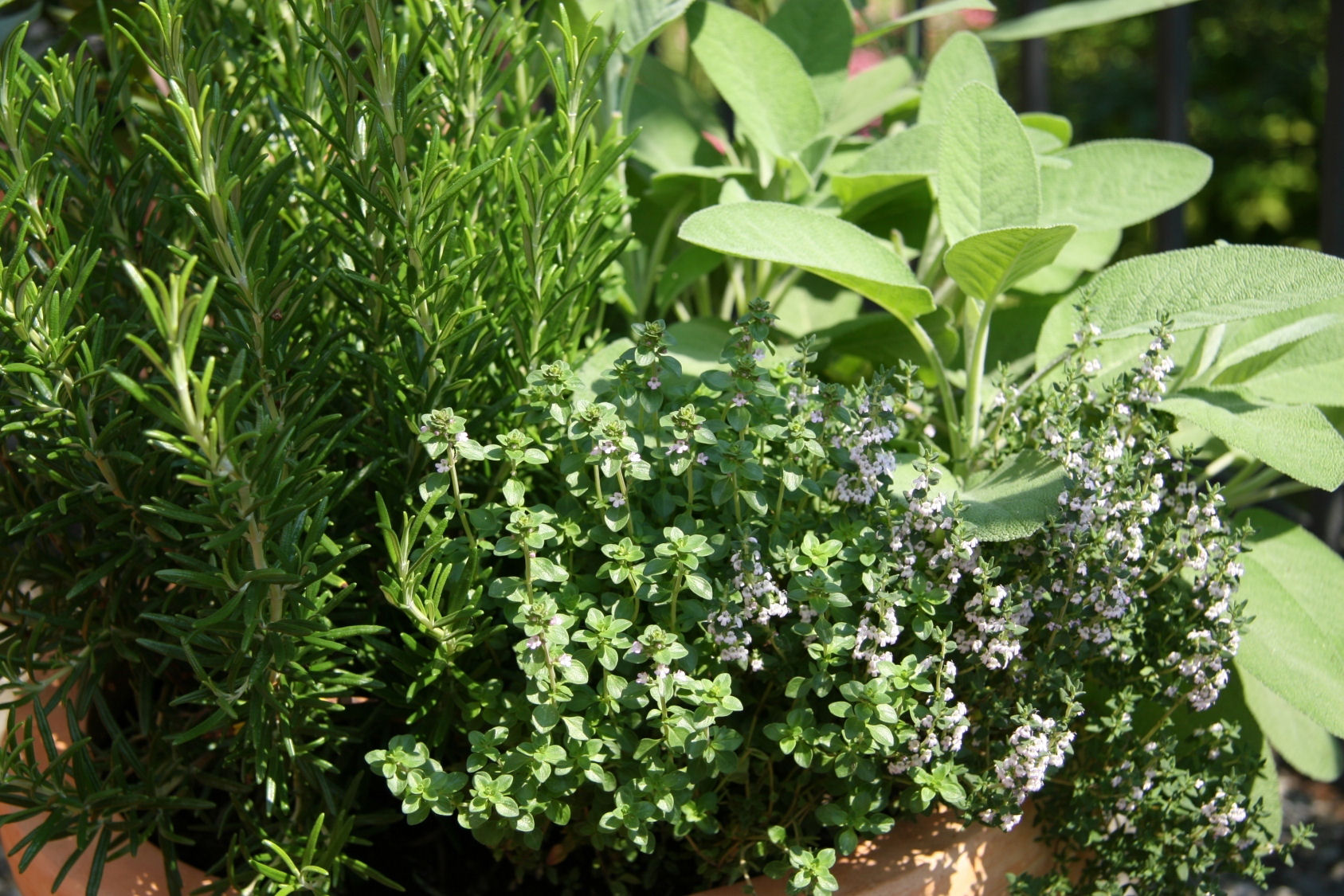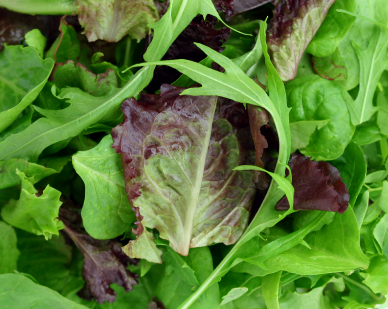Mark Bittman linked to the Simple Dollar's Seven Ideas for Preparing Food at Home Cheaply with Minimal Space and Resources. He requested comments, and with all my edible gardening efforts I found I was droning on at some length so I decided to post here instead.

THE LEAST YOU NEED TO KNOW
To save money by cooking at home with minimal resources, do all the usual grocery tricks and then grow your own herbs, alliums (onions, shallots, garlic, leeks), salad greens and lemons. Having these items on hand--for free!--will exponentially increase the flavor and quality of your dishes, while they themselves require truly minimal (I swear) upkeep and overhead.
Container-Friendly: All of the above can be grown in containers, if you have no yard. In fact, even if you do have a yard, your soil is probably a death trap for anything that's not a lawn, so plant them in containers to start anyway.
Inexpensive: With the possible exception of the lemon tree, the "raw" materials for each are dirt (ha!) cheap.
$3 for Wilting Herbs in Plastic, or $3 for a Living, Ever-Giving Plant? Herb plant starts are a few dollars at most and having fresh herbs available at home will save you a fortune at (not to mention a trip to) the grocery store.
The Gift That Keeps on Giving: Thyme, rosemary, sage, chives, mint and oregano are perennial and will last for years. (Basil is annual, not perennial, sadly, but the value proposition may be even stronger for fresh homegrown basil than for the woodier herbs.)
 Garlic In Perpetuity: One store-bought garlic or shallot can be divided into many plantable cloves. The clove will grow into a new head, which can then be divided and perpetuated again. For that matter, you can just use cut the greens off most alliums and use those to flavor your dishes, and leave the original bulb in the ground (the greens will regrow), thus extending the value of just one plant for years on end.
Garlic In Perpetuity: One store-bought garlic or shallot can be divided into many plantable cloves. The clove will grow into a new head, which can then be divided and perpetuated again. For that matter, you can just use cut the greens off most alliums and use those to flavor your dishes, and leave the original bulb in the ground (the greens will regrow), thus extending the value of just one plant for years on end. They're Pretty, Too: Lemon trees are the hardiest of all the citrus trees, and they can withstand an astonishing amount of abuse (too much shade, not enough water, you name it) and still produce a large quantity of fruit.
They're Pretty, Too: Lemon trees are the hardiest of all the citrus trees, and they can withstand an astonishing amount of abuse (too much shade, not enough water, you name it) and still produce a large quantity of fruit. Lemon Tree How-To:
* Buy a dwarf or semi-dwarf variety and keep it in a pot inside during the winter if you are one of those poor fools who don't live in USDA climate zone 9 (like me). And yes, I am gloating.
* If you do live in a temperate area, buy a full-size tree, find a sunny-ish spot near your kitchen door, dig a hole, and stick it in the ground.
* Try to remember to water it sometimes.
* Voila: Fresh whole lemons!
Greensleeves: Salad greens will sprout from the seeds you plant before you finish wiping the dirt off your hands. (OK, that's a slight exaggeration, but as a rule greens germinate very quickly, much faster than, say, beets or carrots. It's almost like instant gratification.)
 Fast and Dirty: The most complicated/high-maintenance plants of the above listed are the salad greens because when exposed to too much heat or sun, some types will "bolt," meaning they'll send up flowers in an effort to eventually throw out seeds and perpetuate themselves. They usually become either bitter or woody when this happens, but again, worst case scenario, they all bolt, you rip them out, you plant new seeds, and five minutes later (or, OK, three weeks) you have new baby greens growing...
Fast and Dirty: The most complicated/high-maintenance plants of the above listed are the salad greens because when exposed to too much heat or sun, some types will "bolt," meaning they'll send up flowers in an effort to eventually throw out seeds and perpetuate themselves. They usually become either bitter or woody when this happens, but again, worst case scenario, they all bolt, you rip them out, you plant new seeds, and five minutes later (or, OK, three weeks) you have new baby greens growing...REFERENCES, RESOURCES, INSPIRATION
Bible for Beginners: If you're a novice gardener (or even if you're not), check out Square-Foot Gardening, which I consider especially appropriate for a salad-greens garden. The short version of the system is: Build a square raised bed, fill it with good soil, divide it up into a grid, plant a small number of seeds close together in the squares (instead of in rows), water, wait, harvest, and then immediately fill in the gap with a new planting.
Understand the Whole System: Gaia's Garden: A Guide to Home Scale Permaculture explains the concept of permaculture and will instantly change your perception of your personal environment. Bird poo will never look the same again. Seriously.

Organic without Agony: Great Garden Companions, which explains how interplanting, companion planting and beneficial insects combine to protect and enhance the health of your garden. Long story short: Plant a lot of things from the daisy (zinnias, marigolds, sunflowers, etc.) and carrot (dill, coriander, Queen Anne's lace) plant families along with your veggies.
Where It All Begins: Teaming with Microbes: A Gardener's Guide to the Soil Food Web, not only explains all of the relevant/essential living creatures/creepy-crawlies resident in healthy garden soil, but is a well-drawn primer of the compost/vermicompost/mulch/aerated compost tea/etc basics.
Leaders by Example: Check out Path to Freedom, the website of the Dervaes family of Pasadena, Calif., a foursome who last year grew 6,000 pounds of edibles on a regular-size city lot. Their pictures alone should inspire you to plant something.
MISCELLANEOUS EDIBLE GARDENING ADVICE
Worm Food: Steer manure (.92 per bag at the garden center) plus espresso grounds from your local coffee house (free for the asking) equals excellent soil (rich, friable and absolutely teaming with worms).
Think Rain Forest, Not Prairie: Most American landscapes are radically underplanted; the biomass that your small lot can support would astound you. Plants want and will fight to live, so don't be afraid to jam them all in there together. Don't assume that they'll die of overcrowding or overgrowing each other. Believe me, plants are built to find sun and water, and they will if it's at all possible.
Table of Elements: The same way that cooking has a million possible gadgets and gizmos but it really comes down to a good knife, a wooden spoon and a hefty pot, gardening really just requires a sturdy spade, pruning shears and good gloves.
Avoid Aggravation: Don't grow sweet corn your first year out; it's a resource-sucking pain in the booty.
Enjoy Reward: Do grow radishes, zucchini and chives your first year out; they are effortless and fool-proof. You'll appreciate the positive feedback.
Someday You'll Believe Me: Indeterminate cherry tomatoes are the devil's fruit. (They will grow endlessly, everywhere, all over the place, forever. Save yourself!)
It All Leads Back to Compost: When and if you want to become a compost nut, read the millions of websites on the topic, stop by the GardenWeb Soil Forum and read The Rodale Book of Composting. That trash bowl you started using in the kitchen because of Rachel Ray will suddenly become your treasure bowl as the leavings of one meal become the makings of a future garden-fresh treat.
Wisdom of the (S)ages: "Feed the soil to feed the plant to feed the people."
OK, that's all for now. Got questions? Got any suggestions of your own? Post in the comments!
2 comments:
Whoo! What an excellent post.
I would say that the single best, easiest, cheapest, best-producing-per-space-allotted food plant I have grown so far has got to be Swiss Chard. It's impossible to kill, doesn't get diseases or bugs, produces like a maniac, and acts like a tender perennial in the LA climate. Plus, you can practice the cut-and-come-again method of lazy gardening. I don't grow mine in a container, but you could easily produce enough for a couple or small family even in a few buckets on your front step.
I am going to check out some of the books you mentioned, thanks for the tips.
Elana said it, this is a truly great post.
Martha
Post a Comment